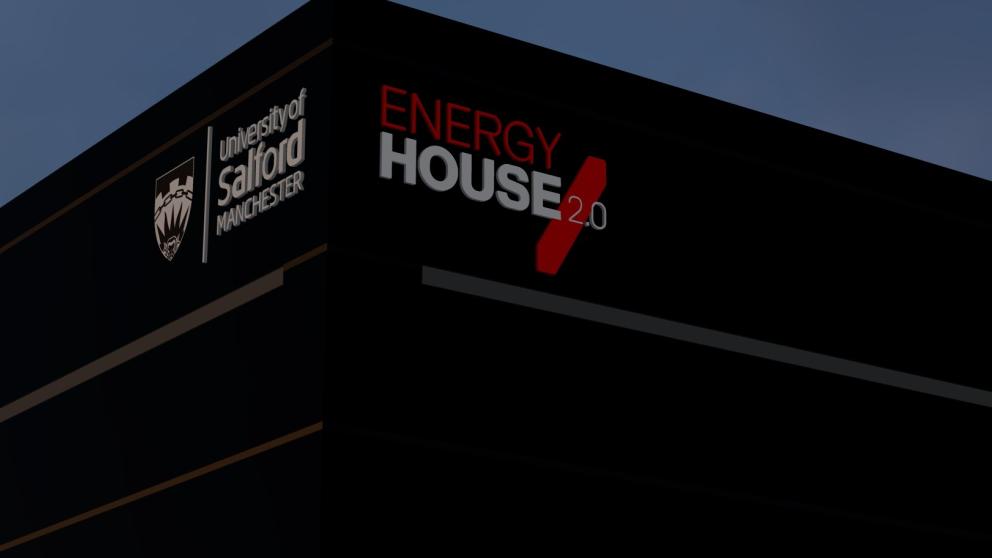Energy House 2.0: Ground broken on weather control energy lab

Construction has begun on the University of Salford’s Energy House 2.0, a £16 million home energy test laboratory in which scientists can undertake research around energy use in homes and small buildings in different weather conditions.
In the new facility the University’s energy and environment academics will be able to create snow, rain, wind or solar exposure in two giant chambers. Different conditions can be generated by a state-of-the-art heating, ventilating and air conditioning system. Temperatures can be plunged to -20°C and raised to 40°C, meaning environmental conditions experienced by 95 per cent of the world’s population can be replicated. The project is the largest of its kind in Europe and has been part-funded by the European Regional Development Fund. The University has expertise in buildings and energy efficiency with research undertaken for over ten years in the original Salford Energy House built in 2011.
The Rt Hon Kwasi Kwarteng, Minister for Business, Energy and Clean Growth said: “Decarbonising buildings is critical to reaching net zero emissions by 2050, which is why I am delighted to see the University of Salford launch the Energy House 2.0 project.
“As we look to build back better from COVID-19, I look forward to seeing how Energy House 2.0 will support businesses regionally, nationally and internationally to deliver a step change in energy efficiency in buildings and create growth and jobs in the green economy.”
Energy House 2.0 will be a major research facility for the UK. It will shape the homes of the future, bring the UK to net carbon zero quicker and help alleviate fuel poverty. It will give insights on how insulation materials, smart energy products and batteries respond to different climate conditions.
Professor William Swan, Director of Energy House Laboratories at the University of Salford said: “Salford has built a fantastic capability in researching energy efficiency at the whole building level. Controlled conditions mean we can repeat experiments in a way that cannot be done outside.
“We can cut study times from years to a matter of weeks. This type of capability allows us to support low carbon innovation in a way that is not possible elsewhere.”
The Mayor of Greater Manchester, Andy Burnham is an advocate of the work undertaken by the team at Energy House and commented that the research and testing that takes place has and will play a role in his vision to make the region a leading green city and carbon neutral by 2038.
Andy Burnham said: “A key part of delivering Greater Manchester’s target to be carbon neutral by 2038 is in reducing emissions from our homes. We need our buildings to become more energy efficient and use renewable energy more effectively, and Energy House 2.0 will help us define how to achieve this. The facilities on offer are unique in the UK and will help businesses to test new equipment and mechanisms to reduce carbon emissions.
“The Energy House team at the University of Salford have been big supporters of the green city-region agenda in Greater Manchester. They have contributed significantly to the development our environmental plans and are one of the founding partners of our new Energy Innovation Agency.
“I am therefore delighted to be able to play a role in the launch of Energy House 2.0. It is an exciting new facility that will not only help to secure a greener Greater Manchester but will put our city-region on the map as an international leader in improving the energy efficiency of our homes and buildings.”
In Energy House 2.0, four furnished houses will sit within the chambers – two in each – with a total footprint of more than 1,000 square meters. Octopus Energy’s future technologies division, the main partner in the project, will enable the lab to have access to 100 percent green electricity, Octopus’s ground-breaking time-of-use tariffs and state-of-the-art energy hardware. The homes will be fitted with smart energy technology including smart meters, in-home displays, and vehicle-to-grid solutions.
There will be space to park electric vehicles and connect them to the homes in order to test vehicle-to-grid (V2G) technology – where renewable energy stored in a car battery pushes power back to the grid – in different weather. The chambers will also be accessible by vehicles to allow for offsite methods to be researched.
Greg Jackson, CEO and founder of Octopus Energy, said: “At Octopus, we use technology to make energy cheaper and greener – so we are delighted to supply the energy and smart technology for one of the most exciting research projects in the UK that is doing just that.”
An online event to mark the start of the building was attended by Andy Burnham, Mayor of Greater Manchester, industry partners Octopus Energy, Barratt Homes, Homely Energy Ltd and Furlong Innovations Ltd.

For all press office enquiries please email communications@salford.ac.uk.
Share:
